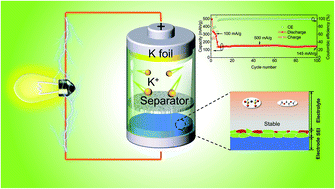Stabilizing BiOCl/Ti3C2Tx hybrids for potassium-ion batteries via solid electrolyte interphase reconstruction†
Abstract
Synergistic innovation from reasonable material design to electrolyte optimization is the key to improving the performance of anode materials for potassium-ion batteries (PIBs). In this work, a two-dimensional van der Waals heterostructure with bismuth oxychloride (BiOCl) nanosheets anchored on MXene (Ti3C2Tx) nanosheets is investigated using a high-concentration potassium bis(fluorosulfonyl)imide (KFSI)–dimethoxyethane (DME) electrolyte. BiOCl nanosheets offer a high potassium-ion storage capacity, while Ti3C2Tx nanosheets provide a fast potassium-ion diffusion channel and alleviate the volume expansion of BiOCl during repeated potassiation/depotassiation. In addition, according to the experimental and computational results, the high-concentration KFSI–DME electrolyte enables the formation of a uniform F-rich inorganic solid electrolyte interphase (SEI) film on the surface of the anode material. As a result, the composite delivers a reversible specific capacity of 262 mA h g−1 at 50 mA g−1, and retains a capacity of 145 mA h g−1 after 100 cycles at 500 mA g−1. This work is expected to provide some enlightenment for the development of stable anodes for high-performance PIBs.



 Please wait while we load your content...
Please wait while we load your content...